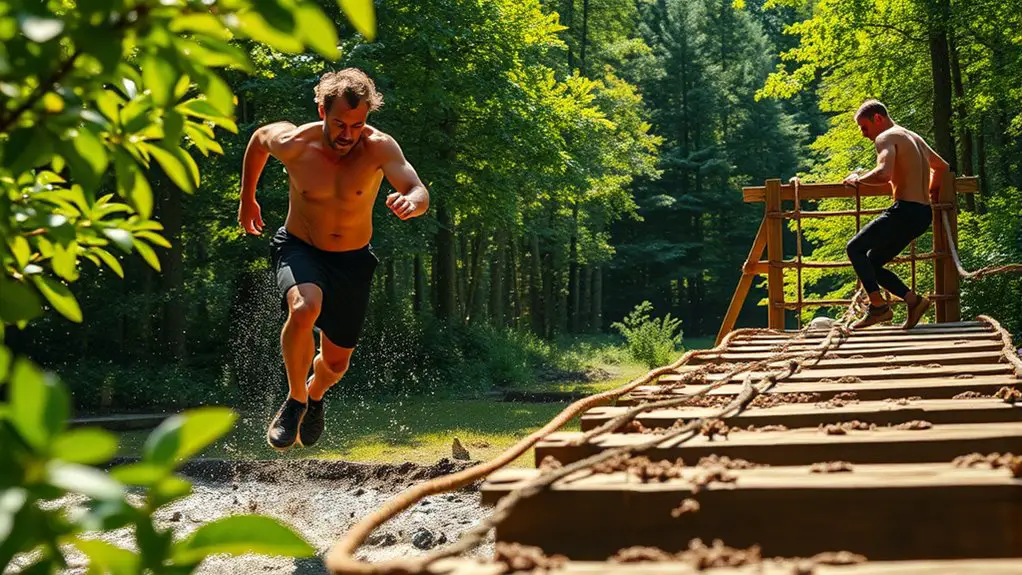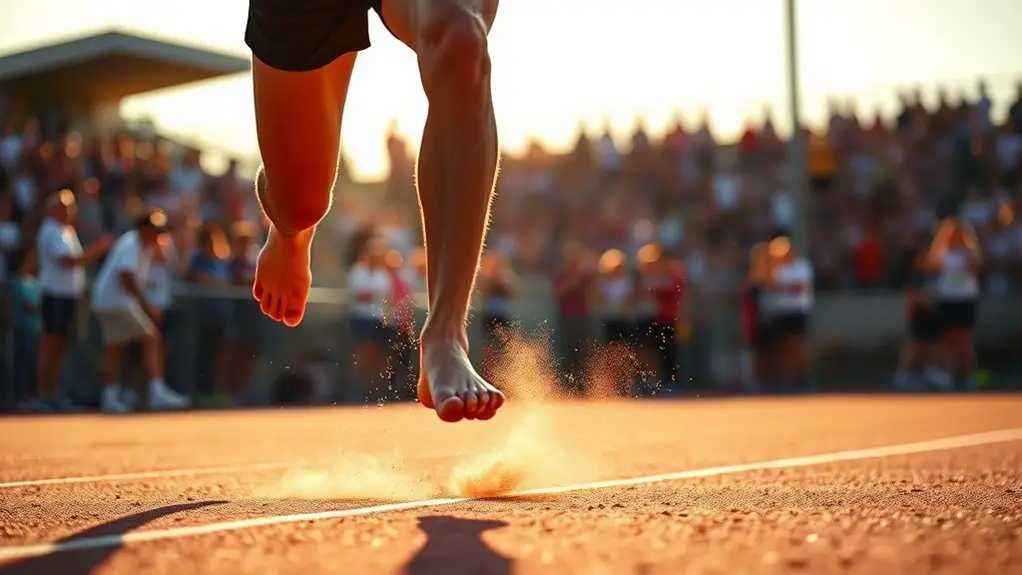To train for obstacle course races, you need a balanced approach. Focus on strength training with compound exercises, build your endurance through longer runs and interval training, and improve agility with drills. Don't forget to master specific obstacles and develop your grip strength. Nutrition is key—fuel your body with whole foods and stay hydrated. Finally, mental preparation is vital for building resilience. Keep going, and you'll uncover more strategies to enhance your performance.
Understanding the Basics of Obstacle Course Racing
Obstacle course racing (OCR) combines physical endurance, agility, and mental strength in a challenging outdoor environment. It's not just about running; it's about maneuvering through various obstacles that test your limits. You'll encounter walls to climb, mud to crawl through, and ropes to swing on. Embracing this adventure means stepping outside your comfort zone and discovering what your body can truly do.
Understanding the basics of OCR is essential for your success. First, familiarize yourself with the types of obstacles you might face. Each challenge demands different skills, from balance to upper body strength. Next, practice your technique; whether it's mastering a monkey bar or perfecting your stride, every detail matters. Finally, develop a mindset that thrives on freedom and exploration, allowing you to push through the tough parts of your race. With the right approach, you'll not only conquer the course but also find a deeper sense of empowerment within yourself. Additionally, building a solid foundation of strength will significantly enhance your performance on race day.
Building a Strong Foundation: Strength Training
To tackle obstacle course races effectively, you need to build a strong foundation through strength training. Incorporating essential strength exercises will enhance your performance, while core stability is vital for maneuvering obstacles. Let's explore how these elements can elevate your training. Adding exercises like squats and lunges can significantly improve your lower body strength and coordination, crucial for overcoming various obstacles.
Essential Strength Exercises
While preparing for obstacle course races, building a strong foundation through essential strength exercises is important. You'll want to focus on compound movements like squats, deadlifts, and bench presses. These exercises engage multiple muscle groups, boosting your overall strength and endurance. Don't forget to incorporate pull-ups and push-ups to enhance your upper body strength, which is key for overcoming obstacles. Lunges will improve your balance and stability, allowing you to tackle uneven terrain with confidence. Aim for a balanced routine that targets all major muscle groups, ensuring you're prepared for whatever challenges lie ahead. Embrace the freedom that comes with strength; you'll feel empowered as you conquer each obstacle in your path.
Core Stability Importance
Core stability is essential for anyone looking to excel in obstacle course races. It's your body's ability to maintain balance and control, especially during dynamic movements. A strong core helps you navigate through challenges like climbing, crawling, or jumping, giving you the freedom to move confidently without fear of losing your footing.
When your core is stable, you can transfer power efficiently between your upper and lower body, enhancing your overall performance. Incorporate exercises like planks, Russian twists, and mountain climbers into your routine to build this foundation. Remember, a strong core isn't just about aesthetics; it's about functional strength that keeps you agile and resilient on race day. Prioritize core training, and you'll enjoy greater freedom on the course.
Enhancing Endurance for Long-Distance Challenges
As you prepare for long-distance obstacle course races, enhancing your endurance is crucial to conquering not just the miles but also the challenges that lie ahead. Start by incorporating longer runs into your weekly routine. Gradually increase your distance, aiming for a comfortable pace that allows you to breathe freely. Mix in interval training to build stamina; sprint for short bursts followed by a recovery jog.
Don't forget about cross-training—activities like cycling or swimming can boost your cardiovascular fitness while giving your joints a break. Fuel your body with nutritious foods, staying hydrated before, during, and after your workouts. Remember that consistent mileage builds aerobic capacity, so listen to your body; rest days are essential for recovery, keeping you energized for the next challenge.
Finally, practice mental endurance. Visualize your success, embrace the journey, and remember, every step you take brings you closer to freedom and accomplishment on race day.
Developing Agility and Flexibility
To successfully navigate obstacle courses, developing agility and flexibility is essential for overcoming various physical challenges. These skills can help you move swiftly and adapt to unpredictable terrains. Start by incorporating dynamic stretching into your warm-up routine, focusing on movements that mimic the actions you'll encounter on the course. Think lunges, leg swings, and high knees.
Next, work on agility drills like ladder drills, cone sprints, and shuttle runs to sharpen your footwork and quickness. Balance exercises, such as single-leg stands or yoga poses, can enhance coordination and stability. Additionally, integrating strength training into your regimen will further improve your muscle power for directional changes.
Don't forget to include flexibility training through yoga or Pilates to improve your range of motion, making it easier to tackle obstacles with grace. The more agile and flexible you become, the more freedom you'll feel during races, allowing you to glide over challenges with confidence. Embrace the journey, and you'll find joy in every leap and twist!
Mastering Specific Obstacles: Techniques and Tips
While mastering specific obstacles can seem challenging, breaking them down into manageable techniques can make all the difference. Start with grip strength for climbing walls; practice hanging from bars to build endurance. For rope climbs, focus on footwork—using your feet to push up will save your arms.
When tackling balance beams, remember to engage your core and keep your eyes fixed ahead. If you're faced with walls, work on explosive jumps and practice the technique of "kipping" to gain momentum.
Don't forget about crawling under barriers; practice low crawls to build both strength and speed.
Lastly, visualize each obstacle in your mind before attempting it. This mental rehearsal can boost your confidence and performance. By honing these specific techniques, you'll conquer obstacles with a sense of freedom and fluidity, making your race experience exhilarating. Additionally, enhancing your proprioceptive abilities through targeted exercises can further improve your balance and coordination on challenging terrains.
Incorporating Functional Training Into Your Routine
To conquer obstacle course races, you need to build a strong foundation with functional training. Focusing on core strength development will enhance your stability, while agility and balance training can improve your overall performance on the course. Additionally, incorporating mobility training into your routine can further enhance your range of motion and reduce the risk of injuries. Let's explore how to seamlessly incorporate these elements into your routine.
Core Strength Development
How can you effectively develop core strength for obstacle course races? Start by incorporating functional training into your routine. Focus on exercises that mimic the movements you'll face during the race, like climbing, jumping, and crawling. Planks, Russian twists, and medicine ball slams are fantastic for building stability and endurance. Don't forget to engage your entire core—front, sides, and back—for a well-rounded approach.
Consider using tools like stability balls or resistance bands to add variety and challenge your muscles. Aim for a mix of strength and dynamic movements to develop the explosive power necessary for tackling obstacles. Remember, the more functional your training, the better you'll perform when you tackle those exhilarating challenges. Embrace the journey to freedom and strength!
Agility and Balance Training
As you prepare for obstacle course races, incorporating agility and balance training into your routine is essential for enhancing your overall performance. These skills help you navigate uneven terrain, dodge obstacles, and maintain control during challenging sections of the course. Start with ladder drills for quick footwork and cone drills to improve directional changes. Don't forget balance exercises like single-leg stands or stability ball work, which can boost your core stability. Consider incorporating dynamic movements, like box jumps or lateral hops, to mimic race conditions. Remember, the more agile and balanced you are, the freer you'll feel as you tackle each obstacle. Embrace the journey, and watch your confidence soar as you conquer those challenges with ease!
The Importance of Nutrition for OCR Performance
While you might focus on strength and agility for obstacle course races, nutrition plays an essential role in your overall performance. The right fuel can make all the difference when you're tackling tough challenges. Eating a balanced diet rich in whole foods—fruits, vegetables, lean proteins, and healthy fats—will help you build endurance and recover faster. Adequate protein intake reduces soreness and accelerates recovery time, which is vital for optimal performance.
Don't underestimate the power of hydration, either. Staying properly hydrated keeps your energy levels up and helps prevent fatigue during races. Carbohydrates are your best friend; they provide the quick energy you need to conquer obstacles.
Consider timing your meals around training sessions, too. A pre-race snack can boost your performance, while post-race nutrition aids recovery.
Ultimately, embracing a mindful approach to what you eat empowers you to perform at your best and enjoy the freedom of movement on race day. Fuel your passion, and let your body thrive!
Mental Preparation: Building Resilience and Focus
Mental preparation is just as essential as physical training for obstacle course races. You'll want to explore visualization techniques to picture your success, embrace discomfort during tough moments, and incorporate mindfulness practices to sharpen your focus. These strategies can help you build resilience and stay mentally strong throughout your race. Additionally, practicing mindfulness meditation can enhance your focus and reduce anxiety, allowing you to perform at your peak during races.
Visualization Techniques for Success
Harnessing the power of visualization can elevate your performance in obstacle course races. Picture yourself conquering each challenge with confidence and ease. Close your eyes and imagine scaling walls, crawling under barriers, and running through mud effortlessly. This mental rehearsal not only boosts your confidence but also prepares your mind for the physical demands ahead.
Take a few moments daily to visualize your race day, focusing on each obstacle and how you'll tackle it. Feel the adrenaline, hear the crowd, and embrace the exhilaration. By doing this, you'll program your brain for success, allowing you to respond effectively under pressure. With practice, visualization becomes a powerful tool, helping you maintain focus and resilience, ultimately leading to your freedom on the course.
Embracing Discomfort and Challenges
Embracing discomfort is essential for developing resilience and focus in obstacle course racing. When you push your limits, you learn to navigate challenges with confidence. Instead of shying away from tough moments, lean into them. Here's a quick look at how discomfort can shape your training:
| Challenge | Benefit |
|---|---|
| Cold water exposure | Builds mental toughness |
| Heavy lifting | Enhances physical strength |
| Long runs | Improves endurance |
| Technical obstacles | Boosts problem-solving skills |
Mindfulness Practices for Focus
In the fast-paced world of obstacle course racing, maintaining focus can be your secret weapon. Mindfulness practices like meditation or breath control help you center your thoughts and sharpen your concentration. When you're on the course, distractions are everywhere; training your mind can keep you in the moment. Try setting aside a few minutes daily to focus on your breath, letting thoughts drift away. Visualization techniques can also enhance your performance—imagine yourself conquering each obstacle smoothly. Embrace the freedom that comes with a calm mind; it'll help you push through tough moments. Remember, it's not just about physical strength; mental clarity is key to overcoming challenges and achieving your personal best in every race.
Practicing With Mock Races and Training Sessions
While mock races and training sessions might seem like just another part of your preparation, they play an essential role in getting you ready for the real thing. These events let you experience the adrenaline and pressure of race day without the stakes being as high. You'll get to test your physical limits, practice your pacing, and refine your obstacle techniques in a supportive environment.
During these sessions, you'll also learn how to manage your energy and strategize your approach to different challenges. Plus, you can work on your mental game—facing obstacles head-on in a mock setting helps build confidence for the actual race.
Recovery Strategies to Optimize Your Training
Since recovery is just as essential as your training, implementing effective strategies can greatly enhance your performance in obstacle course races. Prioritize sleep; it's your body's best tool for healing and rejuvenation. Aim for 7-9 hours of quality rest each night to restore your energy and muscle function. Hydration's key, too. Drink plenty of water before, during, and after your workouts to keep your body in peak condition.
Incorporate active recovery days into your routine; light activities like yoga or walking can keep your blood flowing. Don't forget nutrition—fuel your body with a balanced diet rich in proteins, healthy fats, and carbohydrates to support muscle repair. Stretching and foam rolling are excellent for easing tension and preventing injury. Additionally, proper nutrition strategies can significantly enhance your recovery and performance. Finally, listen to your body. If you feel fatigued or sore, give yourself permission to rest. Embracing these recovery strategies will empower you to tackle those obstacles with confidence and vigor.
Frequently Asked Questions
What Shoes Are Best for Obstacle Course Racing?
When picking shoes for obstacle course racing, you'll want lightweight, durable footwear with good traction. Look for options that offer support and drainage, so your feet stay comfortable and agile during those challenging courses.
How Do I Prevent Injuries During Training?
Did you know that nearly 50% of athletes experience injuries during training? To prevent yours, listen to your body, warm up properly, incorporate rest days, and balance workouts with strength and flexibility training. Freedom's in your hands!
Can I Train for OCR Without a Gym?
Absolutely, you can train for OCR without a gym! Utilize outdoor spaces, parks, and your own body weight. Running, climbing, and creating obstacles at home can mimic the race environment while keeping your training diverse and exciting.
What Should I Wear for an Obstacle Course Race?
For an obstacle course race, wear moisture-wicking clothes and sturdy shoes with good grip. You'll want to avoid anything too loose that might snag. Consider gloves for grip, too, and don't forget sunscreen!
How Do I Choose the Right Race for My Skill Level?
To choose the right race for your skill level, assess your experience, fitness, and comfort with obstacles. Start with beginner-friendly events, then gradually tackle tougher challenges as you gain confidence and strength. Enjoy the journey!




